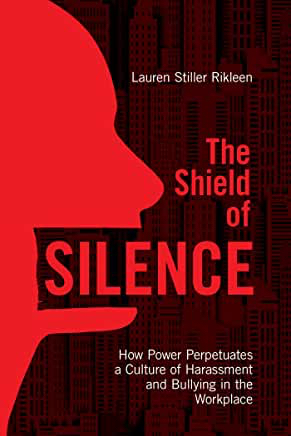By William Carmichael
It is beyond me that workplace harassment and bullying still exists today. And regardless of the business or industry, where should we lay the blame for the toxic culture of malicious abuse that saturates our workplaces? To quote a legal scholar, “The problematic environment stretches far. It includes our schools and colleges, our social media platforms, even our public institutions. Anyone whose eyes are open knows the problem is real. Less obvious is why this toxicity began, what it feeds on, why we tolerate it, and whether we will ever do anything about it.” In The Shield of Silence: How Power Perpetuates a Culture of Harassment and Bullying in the Workplace, Lauren Stiller Rikleen harnesses evidence-based research, countless interviews, and the power of her own intelligence and legal experience. She identifies not only some of the most pernicious root causes of harassment but ventures into how we might overcome its destructive presence.
A Culture of Abuse
According to the author, “Allegations of sexual assault, harassment, and other misconduct are in no way confined to those in positions of privilege. As this book makes clear, it is an endemic result of a culture that devalues women, leaders who do not place a priority on respect and inclusion, and entrenched biases that bloom within structures and processes that fail to support systems to challenge those biases.”
The book also reveals the two dominant factors that perpetuate a culture of abuse: fear and secrecy. Whether or not you’ve experienced workplace harassment, you will nonetheless recognize both factors in an instant, because you’ve likely witnessed them. While a victim may ultimately settle on outrage, anger, frustration—any number of emotions, the first one that everyone experiences who has been targeted by a harasser is fear. It comes most noticeably in cases of physical violence or coercion. Mostly, it triggers a basic fear for one’s safety and bodily integrity. Yet it arises in other forms, just as debilitating. For instance, even a misplaced suggestive or risqué comment engenders fear in the target and renders questions such as, “Will I lose my job? Will he come after me? Will anyone listen? Will anyone believe me and even if they do, will they care?” Understanding that your actions may trigger fear in others unfairly teaches us that the harasser’s real intent is power, not sexual gratification.
As Rikleen articulates, the second factor and perhaps the more destructive is secrecy. Quoting from a Bloomberg Businessweek article about a class action lawsuit against Goldman Sachs, the author highlights, “a culture that fetishizes secrecy and loyalty, that discourages victims from reporting their mistreatment.” Indeed, what Rikleen identifies is that the problem is not just discouragement; the problem is also punishment for speaking up. The result of those consequences is a code of silence. And with silence, the problem persists in all its forms. My initial response to this harmful dynamic was, “Secrecy yes . . . but loyalty to whom?” Of course, the answer to that question often results in actions by those with power that express, “Not to the victims.”
And What About Training?
While The Shield of Silence: The Shield of Silence: How Power Perpetuates a Culture of Harassment and Bullying in the Workplace is validating for anyone who has endured episodes of mistreatment, harassment, and unchecked bullying, it offers so much more. Critically, it sets forth a blueprint for how organizations can go about changing their cultures, not just their policies or practices, but the essence of what has kept them from advancing toward a spirit of alliance and cooperation in eliminating one form of oppression in our workplaces. Clearly this blueprint, among other things, is the need for continued training but there is more than meets the eye here. Unfortunately, most harassment training tends to focus on the prevention of legally actionable behaviors rather than that of influencing true behavioral change. This is where Rikleen’s suggestions to leadership about how to induce real change is so beneficial.
Why This is a Must Read
I recommend The Shield of Silence to anyone who has suffered bullying or harassment at work. I recommend it more urgently to anyone who has perpetrated it or allowed it to continue after learning of it. I recommend it most enthusiastically to those in a position of authority in any organization that hasn’t thoroughly eliminated bias from his or her workplace. Finally, this book is an invitation to consciousness. Bullies sometimes may not even know they are bullying because their way of functioning is all they know. Their lack of awareness is not a justification and should never be one. Nonetheless, this book can help invite awareness. Ultimately, this book compellingly argues that sexual harassment and other negative behaviors will not be stopped unless the condition that drives victims and bystanders into silence, is eliminated.
Structure and Layout
At 176 pages, The Shield of Silence can easily be read over a weekend although I encourage readers to not hurry this one as each of its nine chapters deserves a second walkthrough. And like a textbook, readers will appreciate a very structured and practical layout that is linear by design. Topics are well researched as demonstrated by a Notes section that, quite honestly, is remarkable. So is its Appendix whereby Rikleen provides an informative and descriptive look into #MeToo movement as surveyed by the Women’s Bar Association of Massachusetts. This one is worthy of your time!
Who Will Benefit Most from This Book?
Human Resource Professionals, Corporate Trainers, Management (at all levels)
About the author:
Lauren Stiller Rikleen, president of the Rikleen Institute for Strategic Leadership, is a nationally recognized speaker, consultant, and trainer who provides practical strategies for changing workplace culture, removing obstacles to women’s leadership and advancement, minimizing the impacts of unconscious bias, and strengthening multi-generational teams.

